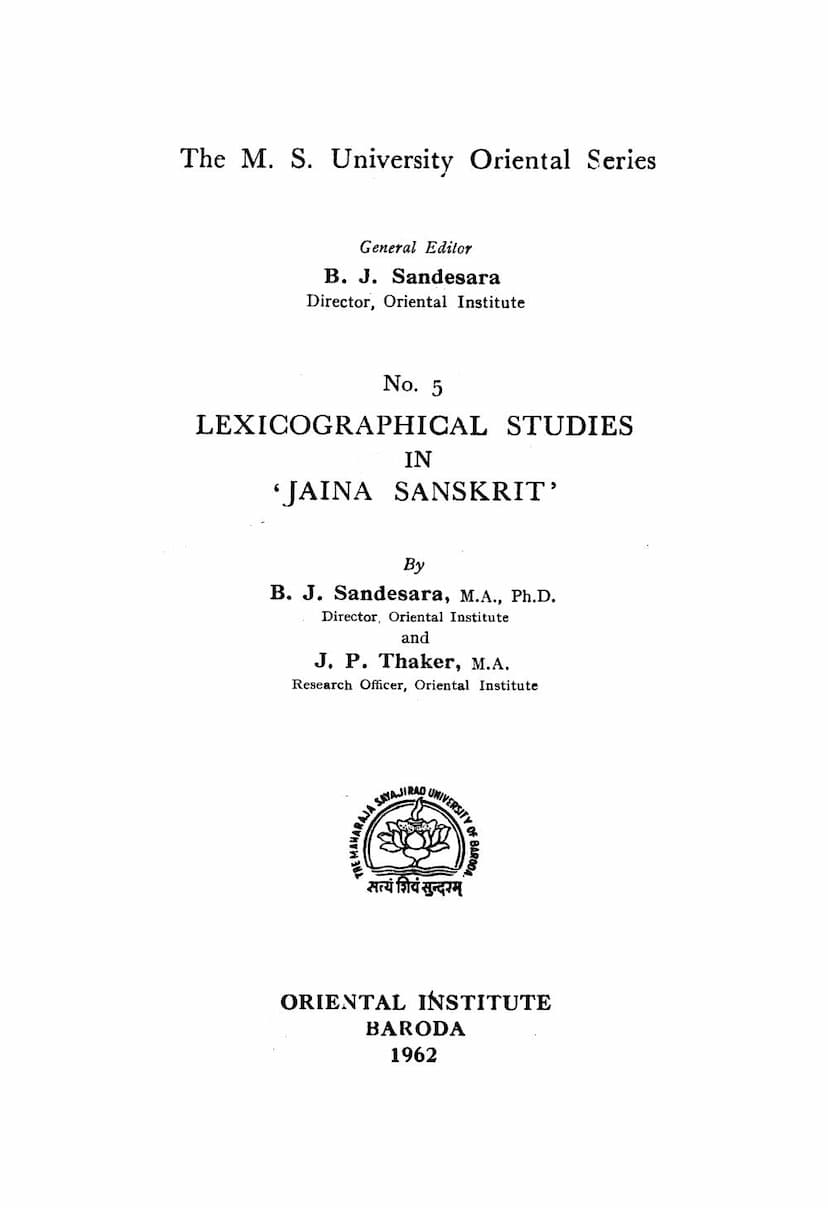Lexicographical Studies In Jaina Sanskrit
Added to library: September 2, 2025

Summary
Here's a comprehensive summary of the Jain text "Lexicographical Studies in Jaina Sanskrit" by B. J. Sandesara and J. P. Thaker, based on the provided pages:
Book Title: Lexicographical Studies in Jaina Sanskrit Author(s): B. J. Sandesara, J. P. Thaker Publisher: Oriental Institute, Baroda Publication Year: 1962
Overview and Purpose:
This book is a collection of lexicographical studies focused on "Jaina Sanskrit," a distinct regional style of Sanskrit used by medieval Jaina authors, particularly in Western India. The authors identify this language as a regional, simple, popular, and colloquial form of Sanskrit, contrasting with Classical Sanskrit. It often incorporates vernacular elements, rare and obsolete words, back-formations, and sometimes hyper-Sanskritism from the spoken dialects of regions where Gujarati and Rajasthani are spoken.
The primary objective of these studies is to provide a detailed vocabulary of noteworthy words found in key Jaina Sanskrit texts, serving a dual purpose:
- Reconstruction of Spoken Sanskrit: To aid in understanding the regional spoken Sanskrit of different areas.
- Linguistic and Cultural Insight: To illuminate the development of modern regional languages (especially Gujarati) and provide insights into the literary, linguistic, and cultural history of the Jaina tradition.
Selected Texts for Study:
The lexicographical studies presented in this book are based on three prominent works of Jaina Prabandha literature:
- Prabandhacintāmaņi of Merutungasūri (1305 A.D.): This is considered a principal sourcebook for the history of medieval Hindu Gujarat, covering the period from the 9th to the 13th century A.D. It is highly valued for its historical anecdotes and its representative use of colloquial Sanskrit.
- Prabandhakośa of Rājasekharasūri (1349 A.D.): Also known as Caturviṁśatiprabandha, this work compiles twenty-four Prabandhas learned from religious elders. It offers a considerable amount of new material of special interest, written in a simple, colloquial Sanskrit prose intended for easy comprehension by those with a working knowledge of the language.
- Purātanaprabandhasangraha (compiled c. 1232 A.D. onwards): This collection contains ancient Prabandhas allied to the contents of the Prabandhacintāmaņi, drawn from various manuscripts. It includes both historical and legendary material crucial for studying ancient history and culture. The language here is noted as being simpler and more archaic than in the other two works, with some Prabandhas potentially predating them.
Methodology and Content:
The studies involve:
- Recording Peculiar Words: Compiling words that are peculiar to Māru-Gurjara language, back-formations, important Jaina technical terms, rare and obsolete words, and those not frequently used in Classical Sanskrit.
- Providing Equivalents: Noting equivalents from Old and Modern Gujarati and other cognate languages whenever possible.
- Illustrative Quotations: Including quotations from the Sanskrit texts, and sometimes from Old Gujarati texts, to demonstrate the usage of vocables.
- Incidental Grammatical Points: Pointing out grammatical peculiarities where relevant to the meaning of a word.
The book includes extensive addenda and corrigenda, indicating the meticulous nature of the research. The lexicon itself is presented alphabetically, with each entry providing the Sanskrit term, its grammatical information (m., f., n., adj., ind.), its meaning, and references to the specific pages and lines in the edited texts.
Significance:
"Lexicographical Studies in Jaina Sanskrit" is a significant contribution to the study of Indian languages and literature. It highlights the importance of Jaina Sanskrit as a bridge between Classical Sanskrit and modern vernacular languages, offering valuable data for linguistic analysis and historical research. The detailed annotations and etymological connections to Gujarati demonstrate the rich interplay between Sanskrit and vernacular languages in medieval India.
Dedication:
The book is respectfully dedicated to Āchārya Jinavijayaji Muni, recognized as a doyen of Prakrit and Jaina Studies in India, acknowledging his crucial role in editing and publishing the selected Prabandha texts.
In essence, this work is a scholarly compilation that meticulously dissects and analyzes a specific linguistic tradition within Jaina literature, providing a valuable resource for scholars of Sanskrit, Prakrit, Gujarati, and Jainology.